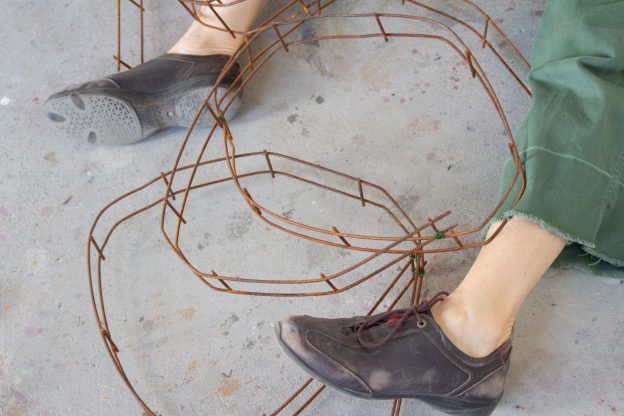With most of the world in varying degrees of lockdown, the effect of the presence or absence of OTHERS is urgently felt. Performance art works with this urgency and indefinable abundance. We take this opportunity to introduce you to three performance artists, who were all in residency when the virus hit Leipzig. As a result, they had to return home unexpectedly just before the residency was due to end.
Tomas Nuñez opens the door
A pretty girl impatiently waits in front of a door. Tomas Nuñez opens it to let her in. Inside was, in fact, outside where he had prepared a piano to play with. I say WITH, because he didn’t play the piano as you might expect, he made the piano play, by using all of its physical parts. He played with the joy of a kid, who free of prior knowlege, is magically able to turn sticks into horses or the wrong side of a piano into an entire orchestra. His orchestral players were a set of sensors which he attached to the strings and body of the piano. He used lots of different actions to produce their voices. It was like he was a surgeon working on the intestines of his patient, as the patient revealed their story.
But that didn’t create a comforting piece of music. It was more that his joy of playing, with all the empathic and mirror neurons we have, showed us also the selfishness of these activities. How different it is to listen or to do it yourself. Aware of that, as an ironic reflection, he asked Maayan Moskona to sit beside him the whole performance and to not pay any attention to what he was doing. This she did.
His Cage-esk performance SILICONE LUTHIER embraced both, the self-obsessed and engrossed player, while breaking taboo by showing the impertinence of it. It Perhaps that empowered the Almost Tension vernissage guests to go wild after he finished. The piano and microphone stayed in play for the rest of the evening.
In sharp contrast was the performance TRACKS from Sarah bild during the same vernissage. She sees her performances as shared time to disclose ourselves to each other. Political analyst Hannah Ahrend described how relevant time can be in our understanding of each other in her book The Human Condition. We need time to interact, and to experience being exposed beings amongst others who, in their introspect, are exposed beings as well.
Sarah Bild incorporates found items
Sarah carried several items up and down the stairs, these items were in direct opposition to her organic body. They were mainly rusted steel, spiraled around her arms, legs and torso, but also around a large branch. These items influenced the movements of her body. Wearing them as cloth AND burden, she went through a multitude of feelings as she tried to deal with them as something non-negotiable. Sarah had a strong presence in the exhibiton, perhaps more than she expected. Perhaps because in Leipzig the collective concious has a strong memory of the un negotiable, too.
At first glance, this could be the end: not negotiating. But no! Audrey Newton isn’t standing for it either. In her performance, SMASH THE ARMOUR, she demolished the sculpture she had made for RD 42’s final show Hard Fluid Betrayal. She hit, kicked and damaged it, disrupting the self-assurance of the once so proud sculpture, breaking the parts into pieces to get to the gold.
“Break, rupture, chop, rip, crack, hurt, injure, disrupt, kick, drop, punch, interrupt, cut, damage, slit, fracture, annoy, manipulate. Get to the gold. I dare you.” Audrey Newton
This activity was unrepeatable and unforgivable, but alleviating. That is, if we follow Hannah Ahrend in her thoughts about action: all real activity. You can’t do things the same way twice. All action has boundless consequences, often going far beyond what we could anticipate. That´s what makes it so neccessary to be in contact with people and why we miss it so desperately. Without them we are not able to act, good or bad.
written by Julianne Csapo

